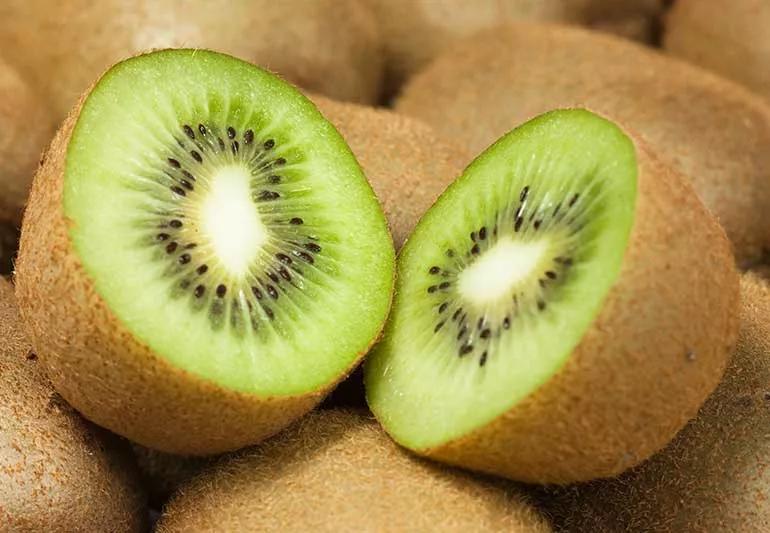That fuzzy, brown skin is actually loaded with nutrients

How do you eat your kiwi? Maybe you slice it, admiring the neon green fruit and bright white core inside. Or maybe you scoop it out with a spoon, using the thin, brown skin as nature’s little cup for the tangy fruit inside.
Advertisement
Cleveland Clinic is a non-profit academic medical center. Advertising on our site helps support our mission. We do not endorse non-Cleveland Clinic products or services. Policy
But did you know that every part of the kiwifruit is edible? Like … all of it?
That’s right: If you’re so inclined, you can, in fact, bite right into a kiwi the same way you chomp on an apple — skin and all. It’s actually really good for you!
Kiwifruit itself has all kinds of health benefits, and the skin only adds to those benefits. But first, a word about the differences in types of kiwis.
“There are about 60 species of kiwifruit, and all of them have edible skins that vary in texture and consistency,” explains registered dietitian Gillian Culbertson, RD, LD. “The most commonly eaten versions are green and gold.”
There are also different varieties of kiwis, depending on where they’re grown, which can result in slightly different tastes and nutrient makeup. Whichever kind of kiwi you choose, here are some of the benefits you can expect.
Advertisement
Fiber is the part of plant foods that your body can’t digest — which, perhaps counterintuitively, actually helps keep your digestive system running smoothly. Fiber reduces bloating and helps you poop.
“Kiwis are already a good source of fiber, but if you leave the skin on, you’ll get even more of it,” Culbertson says.
Eating a whole kiwi with the skin on increases its fiber content by a whopping 50% more than if you eat it without its skin. One skin-on green kiwi has 3.5 grams of fiber, while a skin-on gold kiwi has about 3 grams of fiber.
Kiwi skin packs an antioxidant-filled punch: It has three times more antioxidants than the fruit itself! Antioxidants help your body fight free radicals, unstable molecules in your body that, if left unchecked, can lead to cellular damage and cause signs of aging and disease.
Antioxidants in kiwi skin include:
The skin of a gold kiwifruit increases your folate intake by 34%. Folate, also known as vitamin B9, helps your body turn carbohydrates into fuel (glucose) to produce energy.
“It’s critical for your liver, skin, hair and eyes, and it helps keep your nervous system working properly,” Culbertson says. “It’s especially important that people who are pregnant because folate deficiencies can lead to complications like birth defects and anemia.”
If you have a history of kidney stones, steer clear of kiwi skins. “They’re high in oxalates, which can increase the chance of developing kidney stones in people with a history of them,” Culbertson states.
Oxalates are natural substances found in some plant-based foods, including spinach, nuts and, yes, kiwi. They don’t have much function in the body, and they come out in urine — but some people are more sensitive to oxalates.
“They can mix with the calcium in your body, which stops it from being absorbed properly and can cause oxalate crystals to form in your kidneys and joints,” Culbertson explains. “This can lead to kidney stones or gout.”
The American Urological Association recommends that people who are prone to kidney stones avoid eating oxalate-rich foods.
Advertisement
You don’t have to do anything special to eat a whole kiwi. You can just bite in! But if you’re nervous about eating the fuzzy outside of the fruit, here are some tips:
However you choose to get your kiwi fix, your body will thank you for keeping the skin on. Embrace the fuzz!
Advertisement
Learn more about our editorial process.
Advertisement

The small red fruit is a good source of potassium and vitamin C — and may support your gut and brain health

This fruit has clear nutritional benefits — but there’s little evidence it can prevent or treat illness

The tropical fruit is a good source of fiber and antioxidants and may help reduce inflammation

Oranges, grapefruits, lemons, limes and other citrus fruits have nutrients that help support immune system, heart and gut health

High in vitamin A, antioxidants, fiber and potassium, this winter squash helps protect your eyes, heart and gut

This glorious green superfood is full of vitamins, minerals and lots of other healthy stuff

High in antioxidants, this superfood offers many health benefits, including improving digestion and lowering cholesterol

Babies can get congested easily, but you can calm their cough by keeping them hydrated, using nasal drops and running a humidifier

Weight loss may cause loose, sagging skin and muscle loss to your rear

Several conditions, like vitiligo and fungal infection, can cause a loss of pigmentation, leading to white spots or patches on your skin